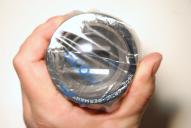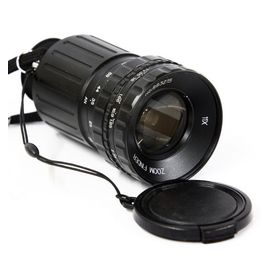
It allows to keep PV going, with more focus towards AI, but keeping be one of the few truly independent places.
-
I use this. It works great. I mainly use it on scouts along with a light meter. I've actually been able to set up, and light shots on an adjacent set while the main cam was in play on the hot set with this and my digisix, and with minimal adjustments we were able to start filming almost immediately after the move to the new set.
http://itunes.apple.com/us/app/artemis-directors-viewfinder/id324917457?mt=8
-
Bolex viewfinder. Discreet, in pocket, for reccys.
http://www.ebay.com/sch/i.html?_nkw=bolex+viewfinder&_armrs=1&_from=R40&_ipg=&_trksid=m37
-
I have Artemis and it works OK, but a director friend of mine has this: http://opteka.com/optekamicroprofessionaldirectorsviewfinderwith11xzoom.aspx
And we use it all the time, very simple and easy.
-
For viewfinder, I use my previous camera Sony HX9V compact (does 1080/50p as B camera) ... It has 16x zoom and magnetic viewfinder loupe too if required in sunlight. Its VF displays magnification settings (e.g. 2x, 4.5x) rather than mm so just need to know key conversions. (That Artemis app looks fantastic @shian !)
-
I use an old Tewe-Berlin. It looks like the one in the link below but mine also has an adjustable aspect ratio that maxes out at 2.55 scope (very nice to have). I bought it 15 years ago. Nice thing about the Tewes is that the zoom barrel ring is fully exposed. No matter what format I am shooting, during prep I put a piece of tape over the 0-99 numbers and mark where the focal lengths for the format I am working with fall on the Tewe's scale and mark the tape with a ultra-fine point sharpie. I also make a mark to align the to the zero of the Tewe's scale (a sort of registration mark) and note the sensor size (Super16, 2/3rds, MFT, whatever). I then save that piece of cloth tape, or just put another one on top. I end up with proper markings for many formats and as new formats come out I just use another piece of tape... Keepin' it simple!
Even if it's a video job with one zoom, during scouting or shooting I always know if the wide or tight end of the zoom (or my primes, if I have some) will cover what we want to see. It is also a big help to directors to visualize what the frame will actually be (and vain directors love to hang it around their neck).
The Tewe's are old, but have low-ish distortion on the wide end and are very accurate with my method above or for Std 35mm (not Super35) as it was designed. I also have to have a small piece of tape to hold the aspect-ratio ring where I left it, but Tewe's are smaller than the Alan Gordon Mark 5 & the Isco Directors Finder and even with a little tape on it, it just makes me look like "I've done this before".
I picked up 2 Iscos "new-old-stock" really cheap in a liquidation and recently sold them on Ebay. They were big (photo attached), heavy and like the Alan Gordon Mark 4, 5, 6, the focal lengths are covered by a metal housing, making my cheat with the tape for new formats impossible and I found they weren't very accurate. Such finders are not future proof, like my ancient Tewe.
Granted, directors finders are great when working with big cameras, you don't own, but, if all you shoot with is a camera you own and a zoom (ex: GH2 and 14-140) I don't think there are many situations where a finder will be needed (as you'll probably have your camera on you) and perhaps the accessibility of the iPhone app (@shain) might be handier and lighter.

 Big ISCOfinder.JPG1936 x 1296 - 252K
Big ISCOfinder.JPG1936 x 1296 - 252K -
@pundit Yeah android users have that app to i've used it before
-
@pundit check this one out: http://www.appbrain.com/app/sl-directors-viewfinder/com.SRLFilmTools
Howdy, Stranger!
It looks like you're new here. If you want to get involved, click one of these buttons!
Categories
- Topics List23,964
- Blog5,723
- General and News1,342
- Hacks and Patches1,151
- ↳ Top Settings33
- ↳ Beginners254
- ↳ Archives402
- ↳ Hacks News and Development56
- Cameras2,361
- ↳ Panasonic990
- ↳ Canon118
- ↳ Sony154
- ↳ Nikon96
- ↳ Pentax and Samsung70
- ↳ Olympus and Fujifilm99
- ↳ Compacts and Camcorders299
- ↳ Smartphones for video97
- ↳ Pro Video Cameras191
- ↳ BlackMagic and other raw cameras121
- Skill1,961
- ↳ Business and distribution66
- ↳ Preparation, scripts and legal38
- ↳ Art149
- ↳ Import, Convert, Exporting291
- ↳ Editors191
- ↳ Effects and stunts115
- ↳ Color grading197
- ↳ Sound and Music280
- ↳ Lighting96
- ↳ Software and storage tips267
- Gear5,414
- ↳ Filters, Adapters, Matte boxes344
- ↳ Lenses1,579
- ↳ Follow focus and gears93
- ↳ Sound498
- ↳ Lighting gear314
- ↳ Camera movement230
- ↳ Gimbals and copters302
- ↳ Rigs and related stuff272
- ↳ Power solutions83
- ↳ Monitors and viewfinders339
- ↳ Tripods and fluid heads139
- ↳ Storage286
- ↳ Computers and studio gear560
- ↳ VR and 3D248
- Showcase1,859
- Marketplace2,834
- Offtopic1,319
Tags in Topic
- lens 457
- viewfinder 21
- frame 20
- loupe 14
- directors 6
- perspective 2
- framing 2
- dop 1













